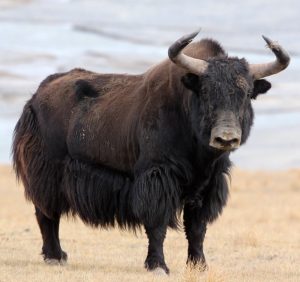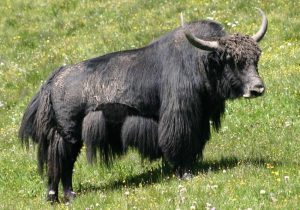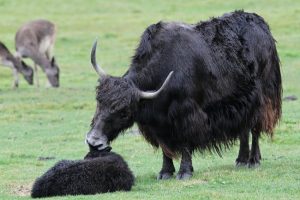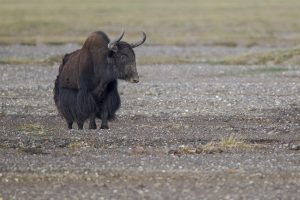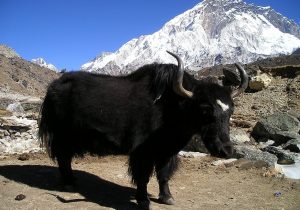Wild Yak
The largest of all living creatures of the mountainous regions, the wild yak is an herbivorous species. Although domestic yaks have come from wild ones (wild yaks who got domesticated millions of years ago), they are now considered as two different species.
Scientific Classification
| Kingdom | Animalia |
| Phylum | Chordata |
| Class | Mammalia |
| Order | Artiodactyla |
| Family | Bovidae |
| Subfamily | Bovinae |
| Genus | Bos |
| Scientific Name | Bos mutus |
Quick Information
| Description | Size: The length of males is 8.2-11ft (249-335 m) from head to body and the tail is 24-39 in (60.9-99 cm Weight: Males are 660-2,205 lb (299-1000 kg) and females are lighter than them Color: Dark brown or black body with the muzzle being grey |
| Distribution | Western Qinghai(China), southern Xinjiang (China), northern Tibet, and Ladakh (India) |
| Habitat | Alpine tundra, mountainous regions and plateaus |
| Sounds and Communication | Grunting noise |
| Lifespan | 20-25 years |
| Diet | Sedges like Kobresia, Stipa, Carex, and grasses |
| Adaptation | 1. The lung of the yak and the physical strength are suitable for frequent climbing on uneven terrains. 2. They have a woolly coat and a fewer number of sweat glands that are good for preserving the body heat and surviving in the cold weather as much as -40°F. 3. The high content of red blood cells and hemoglobin are capable of carrying more oxygen that is required for living in high altitudes. 4. The hearing and smelling abilities of wild yaks are good enough to form an idea of objects and animals miles away. |
| Predators | Snow leopards, brown bears, and Tibetan wolves |
| IUCN Conservation Status | Vulnerable |
Behavior
- Wild yaks travel in herds forming a single line led by the alpha yak. The rest of the yaks follow the exact footsteps of the leader.
- Males and females yaks are either found alone or staying in the same-sex herd. Female yaks stay on higher slopes (at least 1000 meters) than males.
- Yaks often huddle together while confronting a predator. Those who are in the front, lower their horns to scare the enemy.
- During the winter season, yaks consume snow for hydrating themselves while during summer months, they drink plenty of water.
Mating & Reproduction
Throughout the months of July and September, adult male yaks produce grunts and find their mates. They also become hostile during the phase. After the mating, followed by a gestation period of 258-270 days, female yaks give birth to one calf in April-June.
Life-cycle
Calves learn to stand right away and walk within a couple of hours of birth. They remain dependent on their mothers for feeding and other stuff for 1 year. By the age of 2, they become all grown up. While males attain sexual maturity around 6 years of age females are capable of breeding at an early age of 3.
Interesting Facts
- Wild yaks having golden hairs are named wild golden yak and according to Chinese
people they are the endangered subspecies of wild yak. - Only China has a zoo exhibiting a wild yak.
References
- http://tibetnature.net/en/wild-yak/
- https://animalia.bio/wild-yak
- http://www.animalinfo.org/species/artiperi/bos_mutu.htm
- https://www.activewild.com/wild-yak-facts/
Published on February 4th 2019 by Sahana Kanjilal under Coniferous Forest Animals.
Article was last reviewed on 5th December 2024.


